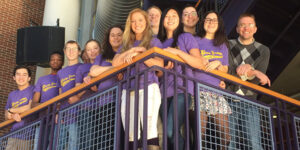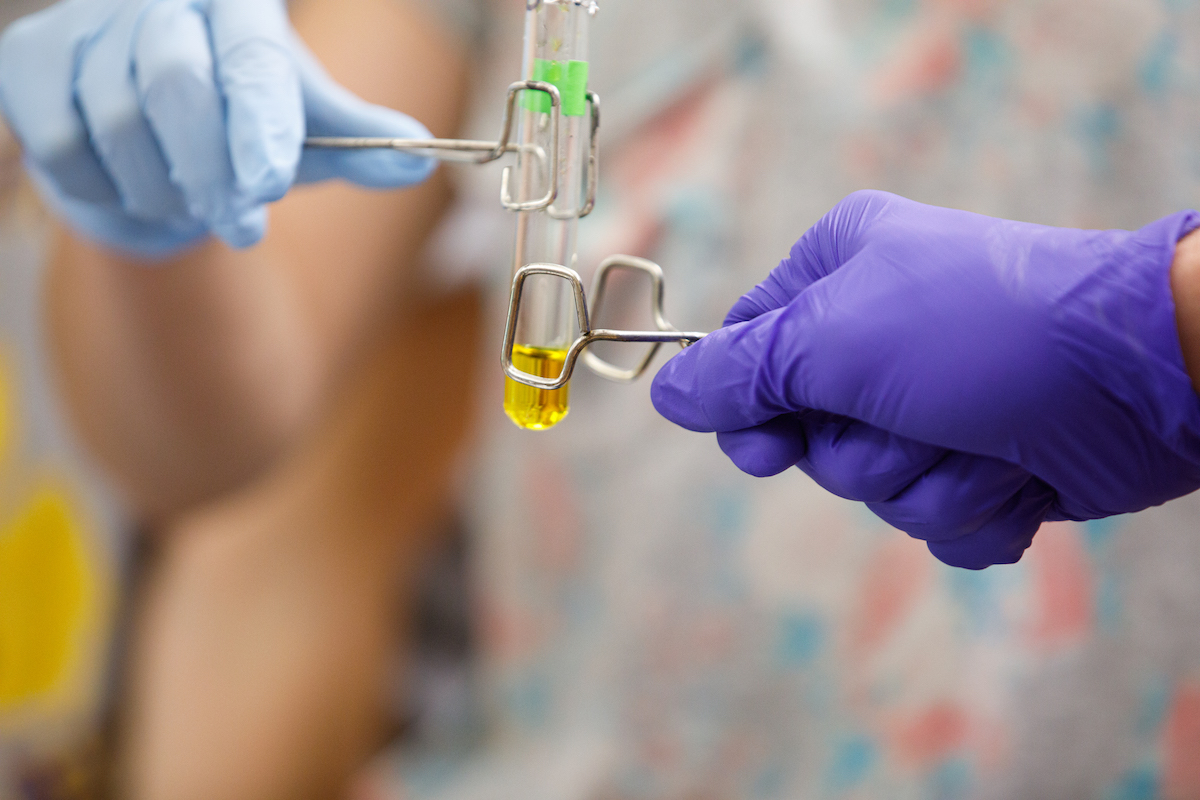For Streu, ’04, Cancer Fight Is a Team Game
Related Programs
Related Posts
Connect With Us
A biochemistry professor, his Albion students, and some excitingly bright research
February 24, 2016

Professor Craig Streu (far right) and his Albion research team. From left: Nalee Riddell, Jordan Newson, Tommy Hall, Chris Armstrong, Alexandra Rola, Maryrose DeBerardino, Lauren Kelsey, Marcin Kazmierczak, Rebecca Ryan, Martina Zafferani and Blanca Estepa Bernabeu.
By Chuck Carlson
Craig Streu won’t say the words. No one can say the words. Not now. Not yet.
They are the words everyone wants to say, everyone wants to hear. In every household and in every corner of the world, they are the words that would change everything.
Maybe, possibly, a cure for cancer awaits somewhere just around the corner.
Maybe it’s a way to finally put cancer on the run once and for all, a way that doesn’t require radiation or chemical or surgical devastation.
It’s been the dream for ages that remains, still, mostly out of reach.
And while Streu—a 2004 Albion graduate in his first year as an assistant professor of biochemistry at his alma mater—won’t say those words, he will allow himself the next best thing.
He ponders the question about whether the work he’s doing with a group of dedicated and driven students could be the next step to finding that cure that will make cancer a thing of the past.
He smiles and answers with all of the diplomacy he can muster.
“It could be one of the tools of the arsenal to cure cancer,” he says.
That’s as far as he’ll go right now, because he knows what lies ahead, and what has come before, when such talk has been broached.
But, at least for the present, it’s far enough.
Lightbulb Moment
Streu works with a core group of 11 known variously as the “Streu Crew” and the “Streu Group,” most of whom are chemistry majors and all of whom understand that, in their little corner of campus, they are doing potentially monumental work.
“There are so many students dying to do research work,” Streu said. “There’s a thirst for opportunity.”
So they gather several times a week in Putnam Hall, looking at chemical methods for studying and modifying biological systems. Their current major project: developing a light-responsive chemotherapy that can be used in battling all sorts of diseases, from Alzheimer’s to arthritis to cancer.
Called photodynamic therapies, the idea is to focus specific light wavelengths at, for example, cancerous tumor tissue to concentrate the effects of chemotherapy to a specific location in the body.
In the future, Streu sees a tiny LED light inserted into the body and focused on the tumor. The result, perhaps, could be the destruction of the tumor altogether without the widespread physical battering that can come from chemotherapy and radiation treatments.
It’s an intriguing possibility and one Streu first began working on five years ago when he was a chemistry professor at St. Mary’s College in Maryland.
“I had an idea when I was doing my post-doctorate fellowship at the University of Pennsylvania,” Streu said. “I saw this group turning genes or DNA on with light. So I thought let’s use the same technique for small-molecule pharmaceuticals. I’ve always been interested in pharmaceutical design.”
And when the Michigan native joined the faculty at Albion this summer, he brought his research with him.
“We’re not the first to work in the field but this is an exciting new area,” he said.
Lock-and-Key Approach
It was over the summer that Tommy Hall, ’17, a biochemistry major from Midland, was asked if he wanted to join the adventure.
Hall said it’s been an experience he could not have imagined.
“I was honestly pretty overwhelmed,” he said. “It’s different from being in the classroom. You have to think differently and be ready to fail. You have to treat things like you’re just going out there and having fun.”
Over the past few months, he and many of the other members have developed their own molecules which they hope will fit into cancer-causing enzymes like a key fits into a lock, shutting down the runaway cells that can develop into cancer.
He hopes to one day create his own molecule which, if successful, will be designed with his initials, “TH.”
Streu has published the group’s most recent findings that point to the potential of light to activate a compound that subsequently kills cancer cells by interfering with their ability to divide.
“Photodynamic therapy is an emerging field,” said Streu, whose group’s research has relied on some complicated as well as unconventional materials, such as $7 flashlights purchased off Amazon.
But the small band at Albion isn’t the only group working in the field.
Indeed, in what Streu refers to as “a real David and Goliath story,” Albion is competing with a much larger, and much better funded, research team at the University of Munich in Germany.
“They’re big and famous and rich,” Streu said with a smile. “But we’ll succeed with wit and guile.”
In truth, the two groups eye each other respectfully, but warily, and keep their research to themselves, though Streu did say his paper received a strong review from his German counterparts.
“We presented our work in April and they then published first in June,” Streu said. “But we’re taking the project in new directions.”
And for Hall, who is leaning toward a career in optometry, this is an opportunity he hopes to look back on with pride.
“I hope the research progresses and I go down as being part of it,” he said. “That would be a huge achievement.”
